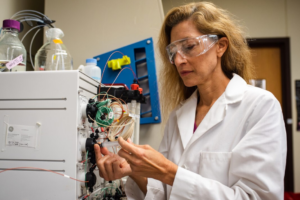Mexico’s emergent energy reforms are generating much excitement for economic development, including increasing the need for highly skilled labor in petroleum engineering, chemistry, geology, physics and geophysics. Up to 2.5 million new jobs by 2025, according to the Manhattan Institute for Policy Research. But, is Mexico’s education system ready for the labor demands of a competitive, international energy market, and will new energy jobs decrease immigration to the U.S.? The bottom line is no.
There are more than 3,000 officially registered higher education institutions in Mexico, of which 60 percent are private. While Mexico has prestigious and internationally recognized public and private universities, such as the National Autonomous University of Mexico (UNAM), the National Polytechnic Institute (IPN), and TEC de Monterrey (ITESM), great disparity and differentiation exist among Mexico’s higher education subsystems. There is no single quality assurance agency, nor a single national higher education entity, and the quality of the different higher education subsystems can vary drastically. There is also no national comprehensive credit system or national qualification framework. All this lack of regulated and mandatory accreditation and consistency in programing makes the Mexican higher education system complex and complicated. Inconsistent and unevaluated English instruction is also a problem for the education system in Mexico, since most of the globalized energy industry handles its business in English.
Enrollment is also an issue. Although Mexico’s education system has been praised for its investment in universal preschool programs, it has a hard time keeping kids in school. At 56 percent, Mexico has the lowest enrollment rate among 15- to 19-year-olds of the 34 countries in the Organization for Economic Cooperation and Development (OECD). This is Mexico’s largest population age group in its history, and almost half are not enrolled in school. In higher education, only 12 percent of Mexican 20- to 29-year-olds participate, according to the OECD, the typical tertiary education age range. Although this is an increase from 2000, it is less than half the rate for Argentina and Chile and across OECD countries of the same age group. Also alarming is the number of youths who are not employed or in education or training programs. OECD indicates that 27.2 percent of 20- to 24-year-olds, and 29.5 percent of 25- to 29-year-olds were not employed or in education or training. This means that the sector of the Mexican population that could ideally meet the new need of a highly skilled labor force is largely undereducated and undertrained.
That is not to say that Mexico has not invested at high proportions in tertiary education in recent years and that the number of engineering students and graduates is high even compared with the U.S., but there is a mismatch between training and opportunity. Most Mexican engineering graduates end up as technicians for foreign-owned companies, not because they are unqualified for better positions, but because those are the current major industry needs. Meanwhile, 80 percent of PEMEX petroleum engineers are generally from two major universities, UNAM and IPN, limiting access to the current best jobs to graduates from these most elite public universities.
Monopolies and oligopolies have historically benefitted from and controlled economic growth in Mexico and have also enjoyed the greatest access to tertiary education. The highly skilled jobs in the energy sector will most likely be filled by several generations of this group and their professional networks, including their foreign professional business partners and investors. In fact, both the Mexican and the U.S. governments have already launched efforts for increased bilateral cooperation and exchange. Companies such as ExxonMobil are making big investments in education in Mexico’s premier universities, including training in English.
But who will be the primary beneficiaries of these emerging opportunities in either the U.S. or Mexico? Of course, some of these opportunities will trickle down, even to construction workers in areas of growth related to energy development, but it is unlikely, at least in the near future, that the Mexican public education system will meet those highly skilled labor needs, nor that energy reform will halt poor, rural migrants, those without access to an elite education, from trying to live an American dream.
Luis Urrieta is an associate professor of cultural studies in education and is affiliated faculty with the Lozano Long Institute of Latin American Studies and the Center of Mexican American Studies at The University of Texas at Austin.
A version of this op-ed appeared in the Houston Chronicle.



